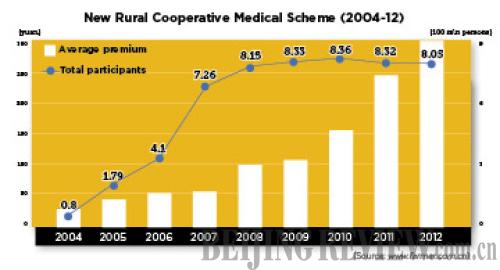|
Although the prices of essential medicines have been reduced by 30 percent on average after the reform, it has harmed the interests of many pharmaceutical companies, drug wholesalers and some local governments that rely on these companies for taxes.
A State Council Executive Meeting in February 2012 decided to complete the reform of county-level public hospitals and start an overall reform on public hospitals in cities in 2015, with the aim of eventually wiping out hospitals' reliance on medicine sales while their services are undervalued.
All the essential medicines are sold at zero profit by community-level medical institutions run by the government, and most of these facilities find it hard to make ends meet as government funding remains insufficient. "More reforms must be conducted to ensure the normal operation of township-level clinics without the profits from medication sales. Otherwise, the essential medicines system will not be soundly implemented," Sun said.
Governance restructuring
A strategy report titled Health China 2020 was released at the China Health Forum 2012 last August. The report, which was initially prepared by the MOH in 2008, suggested the establishment of a health and welfare ministry by merging related departments under the MOH, the National Population and Family Planning Commission, the Ministry of Environmental Protection and the General Administration of Sport.
The report said that issues related to public health fall under the jurisdiction of multiple government departments, which hinders work efficiency. It also called for setting up a cross-department coordinating organization headed by a central government leader and a national health commission based on the Leading Group for Health Care Reform of the State Council.
The report predicted that China's average life expectancy will increase to 77 years by 2020 from 74.83 years in 2010 and national health care input will account for 6.5 to 7 percent of the country's GDP by 2020.
"With the progress of health care reform, we have to address more and much complicated concerns," said Minister Chen at the forum. He said that in the future reform, key issues involving health insurance, drug supplies and medical services will require better coordination between concerned government departments, such as further reforms of public hospitals.
Professor Winnie Chi-Man Yip at the Department of Public Health, University of Oxford, expressed a similar opinion in a paper he co-authored, which was published in Lancet. The paper reviewing China's health care reform stated that governance restructuring for public hospitals is the key to the success of the overall health care reform in China.
Preventive care prioritized
"What makes a good soup for the common cold are the white part of green onions, ginger and dark brown sugar." This is one of the messages on a public billboard of health tips in Yuanming Village, Weiyuan County in northwest China's Gansu Province.
Such billboards containing information on how to prevent and treat common illnesses, which are maintained and updated by local health authorities in every community in Gansu, are part of the province's year-round program of educating the public on staying healthy.
In 2012, the Chinese Government allocated a total of 238 million yuan ($38 million) to support local governments' similar educational programs, which include public awareness campaigns and lectures.
Chang Cuiqing, Director of the Research Division of Sports Nutrition and Biochemistry of the Peking University No.3 Hospital in Beijing, spends a considerable amount of her time every year touring the country and giving speeches on what to eat to stay healthy.
In 2007, Chang was invited by the China Nutrition Society to participate in the drafting of Chinese People's Dietary Guidelines. "We tried to spread nutritional knowledge with the simplest language and an honest attitude," Chang said.
Chen wrote in the preface of this publication, "The next 10 to 20 years are a strategic period for the shaping of Chinese people's dietary habits. With proper guidance, people will adopt healthy diets and reap the benefits for a long time to come. If not, the health of several generations of people will be put at stake and the increased health care costs will eat up the fruit of economic development."
The Health China 2020 report identified a transformation of development models for China's medical sector from focusing on treating diseases to preventing them.
Preventive care is where the strength of traditional Chinese medicine lies. The State Administration of Traditional Chinese Medicine launched a three-year program on promoting preventive care in 2008, which successfully raised the awareness of disease prevention among the public and medical personnel. Preventive care with traditional Chinese medicine has been listed as a basic health care service in Gansu. The government in Qingdao, east China's Shandong Province, has earmarked 10 yuan ($1.6) per person for medical facilities to give a basic health evaluation of senior citizens over 55 years old based on traditional Chinese medicine.
Many medical experts suggest that the philosophy of traditional Chinese medicine for preventing major diseases is in line with the cost-effective guidelines for China's health care reform.
Email us at: tangyuankai@bjreview.com

| 